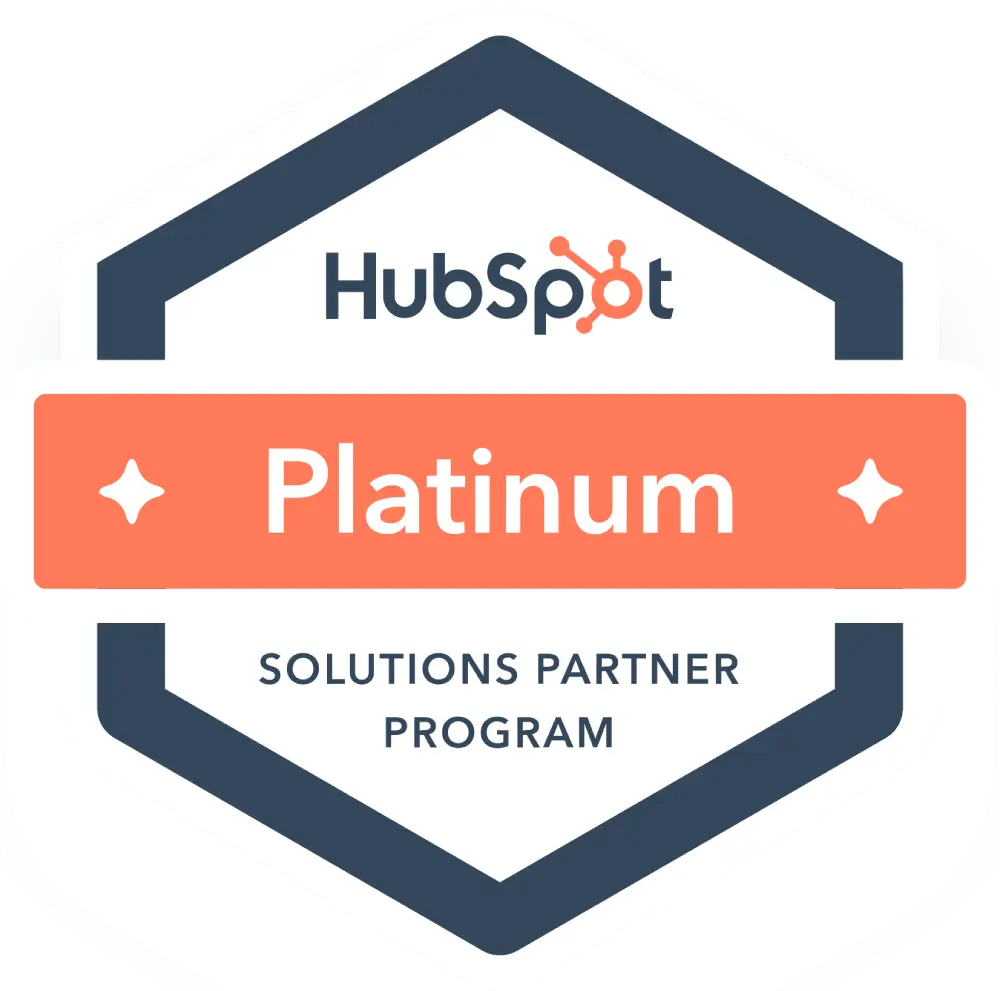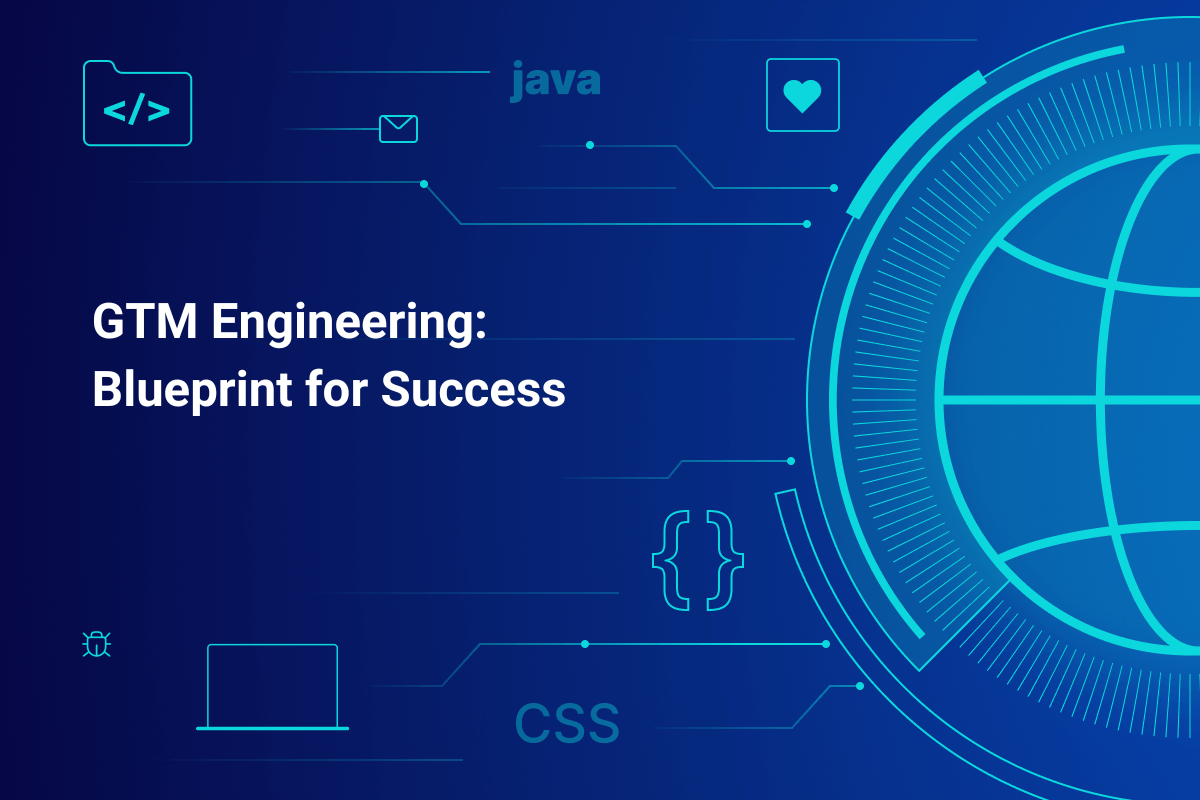When a B2B startup starts to gain significant traction, its go-to-market strategy often isn’t built to handle scale. Sure, it works well enough in the beginning as marketing campaigns generate interest, the product delivers value, and sales teams close early deals. But as demand grows, gaps in operations and information flow emerge.
Data might get scattered across marketing, sales, and product systems, making it hard to get a complete view of an account. Manually assigning leads may slow response times and increase errors. In many cases, product usage signals don’t even reach sales teams. The result is wasted marketing spend, and, worse, missed opportunities with high-intent prospects.
On top of that, AI has not only been the messenger of innovation, but also the proliferator of tools. From AI SDR tools to AI SEO tools. AI content creation tools, AI analytics, AI monitoring, and the list goes one. The go-to-market tech stack has become fragmented across smaller point-and-shoot solutions, with the industry moving towards or away from all-in-one solutions to AI-based specialty solutions.
Nearly 70% of sales reps say the sheer number of tools they rely on to close deals is overwhelming. Seeking someone to pull them out of the tech stack quicksand, Go-to-Market teams have started to turn to GTM Engineers. Go-to-market (GTM) Engineering builds the technical layer connecting marketing, sales, customer success, and product. It unifies data, automates key handoffs, and creates shared visibility so teams can act on the right signals at the right time.
With the proper GTM Engineering foundation, B2B startups stop losing high-intent accounts to process breakdowns. They gain the structure needed to scale efficiently and focus resources where they’ll have the greatest impact. Here’s everything you need to know about GTM engineering, and a blueprint for success to get started.
What is GTM Engineering?
Go-to-Market (GTM) engineering is the discipline of building the systems and infrastructure that power a company’s revenue engine. It gives marketing, sales, and product teams the technical backbone they need to work as one.
GTM engineering combines technical, data, and operational skills to design scalable workflows and shared infrastructure. In practice, this means building data pipelines, automating lead handling and routing, integrating marketing and sales tools, and creating a shared reporting infrastructure that keeps teams aligned. The specialists who design and build these systems are GTM engineers, a relatively new role that is becoming more common at tech companies.
The key purposes of GTM Engineering are to:
- Bridge strategy and execution by turning high-level go-to-market plans into working systems.
- Improve efficiency through automation, standardized processes, and clean data flows.
- Drive revenue growth by ensuring high-intent signals are identified and acted on quickly.
- Address complexity by unifying fragmented tools and data under a single operational framework.
GTM engineering is especially relevant for fast-growing SaaS and tech companies that need to scale their go-to-market execution quickly and efficiently through integrated systems and workflows. In this case, GTM engineers typically work alongside the Revenue Operations (RevOps) team to add the engineering capacity required to build and connect the systems that support revenue growth.

What are the key functions of GTM Engineering?
The key functions of GTM engineering include:
- Systems Integration – Connecting the revenue stack (CRM, MAP, product analytics, data enrichment tools) into a cohesive system so data flows cleanly between platforms and teams have a shared view of the customer journey.
- Pipeline Generation – Building systems that source and prioritize high-quality leads by combining behavioral data with external enrichment, then routing the best opportunities to the right teams.
- Workflow Automation – Replacing manual steps in lead handling, outreach, and follow-up with automated workflows that ensure consistent, timely action.
- Data Enrichment – Filling gaps in account and contact information using data enrichment tools and intent signals to keep targeting up to date.
- Personalization – Enabling tailored interactions at scale by linking operational data with buyer activity to trigger relevant messaging and campaigns.
- Performance Optimization – Tracking how systems perform, identifying friction points, and using those insights to improve conversions and efficiency.
GTM Engineering vs. Other Roles and Functions
GTM Engineering complements existing operational or technical teams by innovating new systems to drive revenue at scale. Here’s how it fits in.
| Function | Primary Focus | How GTM Engineering Complements It |
| Revenue Operations (RevOps) | Standardizing processes and maintaining the existing tech stack. | Builds and tests new automated workflows to extend what RevOps maintains and support faster growth. |
| Sales | Managing the CRM, creating reports, and supporting the sales team’s daily activities. | Automates manual tasks and integrates systems to reduce friction and give Sales cleaner, more actionable data. |
| Traditional Growth Marketing | Brand, messaging, and creative campaign execution. | Focuses on the systematic, automated side of growth by building the infrastructure that powers marketing initiatives. |
| Software Engineering | Developing product features for customers. | Builds internal systems that enable marketing, sales, and customer success to generate revenue more efficiently. |
7 Key Benefits of GTM Engineering
GTM Engineering offers many benefits, including:
- Accelerated Revenue Growth – Shortens sales cycles, improves conversion rates, and lowers acquisition costs through automation and data-driven execution.
- Better Data-Driven Decisions – Provides a single source of truth that supports faster, more confident strategic decisions.
- Cross-Functional Alignment – Connects marketing, sales, product, and customer success through shared data and processes.
- Faster Time-to-Market – Aligns product, marketing, and sales early, enabling faster, more efficient launches.
- Enhanced Personalization at Scale – Delivers tailored messaging automatically, engaging prospects with relevant content at the right moment.
- Improved Customer Experience – Creates seamless, personalized interactions across the customer lifecycle to boost retention and loyalty.
- Competitive Advantage – Enables faster response to market opportunities and builds an automated revenue engine that competitors struggle to match.
Your 8-Step Blueprint for GTM Engineering Success
Here’s a clear framework for getting started with GTM engineering:
Step 1: Define Business Goals and Success Metrics
The go-to-market engineering journey begins with clarity. Before building any systems, you need to decide what outcomes the work will support. Defining goals and success metrics aligns leadership, focuses engineering effort on the correct problems, and creates a shared way to measure impact.
How to do it:
- Align leadership on revenue priorities such as pipeline growth, CAC targets, or shortening sales cycles, and document them in a GTM charter.
- Translate priorities into KPIs like MQL-to-SQL conversion, lead response time, win rate, or ARR growth.
- Define lifecycle stages and ownership across teams so everyone speaks the same language.
- Set SLAs and reporting cadence to create accountability and track progress.
- Baseline your current performance to measure improvement over time.
Step 2: Build Your Technical Foundation
GTM engineering depends on having core systems in place and working correctly before any automation or complex workflows are added. In practice, it means first setting up your CRM as the central source of truth, then connecting it to product analytics and marketing automation platforms, and ensuring basic data flows between them. A solid foundation makes later integrations cleaner and minimizes future rebuilds as your GTM systems evolve.
How to do it:
- Standardize the core stack across your CRM, marketing automation platform, and product analytics so data flows are consistent.
- Secure API access and documentation for every tool to support future engineering work.
- Establish a canonical data model that defines how accounts, contacts, opportunities, and key activities are represented across systems.
- Set up separate staging and production environments with proper access control and logging.
- Implement baseline reporting to give teams early visibility into performance.
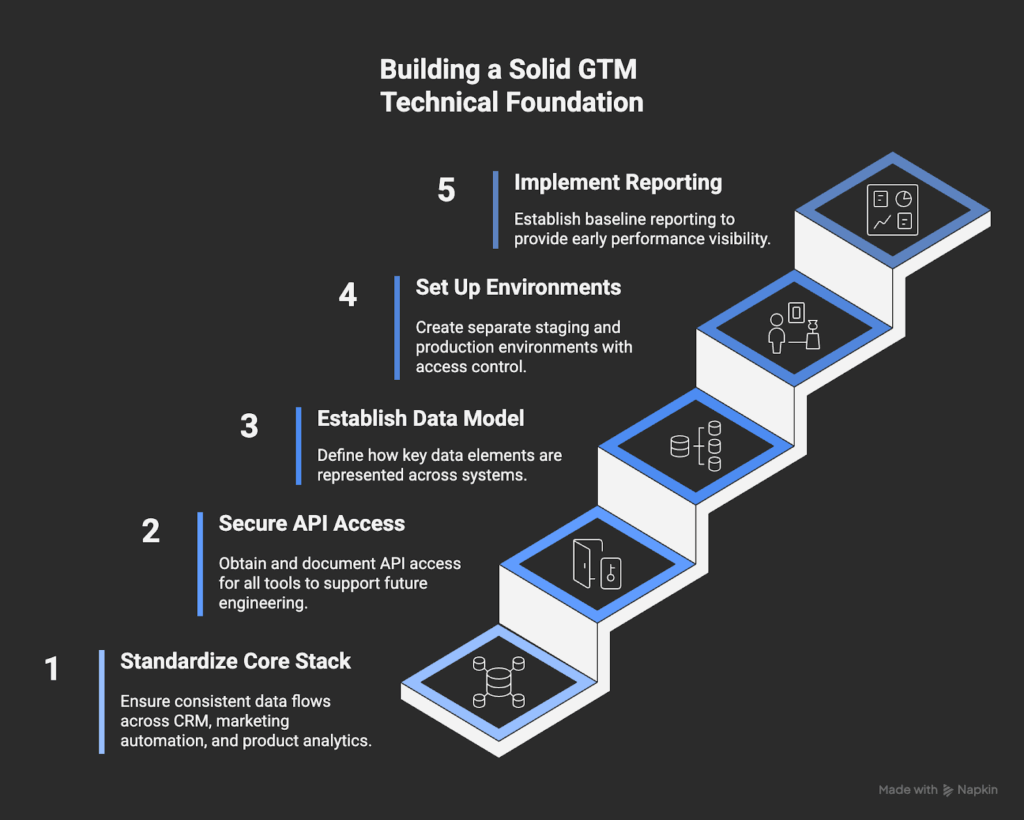
Step 3: Conduct a GTM Ecosystem Audit
A GTM ecosystem audit examines the complete set of tools, data sources, integrations, and go-to-market processes a company relies on to generate and convert demand. It gives a clear view of how systems are connected, how information moves between them, and if there are gaps or overlaps. You’ll want to do this to get a comprehensive understanding of what needs improvement and what you should consider automating.
How to do it:
- Inventory the full GTM tech stack, including unofficial or shadow tools, and document ownership.
- Map end-to-end processes from lead generation through handoff to customer success to show how work really happens.
- Trace data lineage for critical fields to reveal where information originates and how it moves.
- Identify bottlenecks and redundancies that create friction or data loss.
- Document how things work now versus how you want them to work in the future to guide engineering priorities.
Step 4: Clean and Govern Your Data
At this stage, the focus is on making sure the information flowing through your systems is accurate and stays that way. Clean existing data so the systems you build run reliably, then establish data governance to keep it that way over time. Creating clear rules for how data is created, updated, and shared, along with defining ownership and standards, ensures that every team is working from the same information.
How to do it:
- Run a comprehensive data audit across CRM and marketing systems to uncover errors and inconsistencies.
- Standardize field formats, naming conventions, and validation rules to improve accuracy.
- Set deduplication and data enrichment policies to keep records current and consistent.
- Create clear overwrite logic so that enrichment processes do not degrade existing data.
- Define ownership and cadence for regular data hygiene reviews to maintain quality at scale.
Step 5: Start with Simple Automation Projects
By this point, the foundation is in place, so the next step is to target a few straightforward operational gaps that cause the most friction in everyday go-to-market activities. These are often repetitive tasks that slow lead response or create delays in early engagement. Automating them first gives teams quick, visible improvements and builds confidence in the GTM engineering approach before larger, more complex systems are introduced.
How to do it:
- Automate lead routing and follow-ups to cut response times and remove manual steps.
- Launch standardized email sequences to support timely, consistent outreach.
- Trigger data enrichment on intake to improve data quality before it reaches sales.
- Set up alerts for high-intent signals so teams can act quickly.
- Test new automations with a small segment, such as a single team or region, to make sure they work as expected before rolling them out more widely.
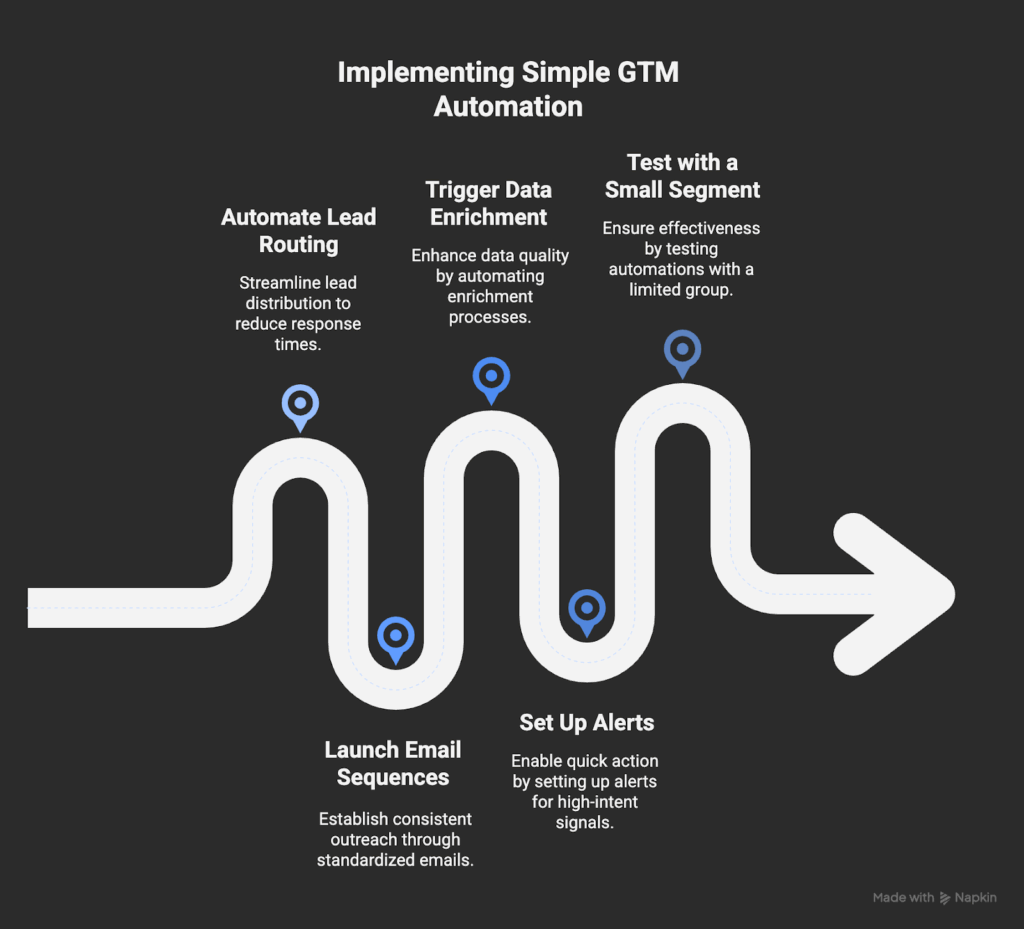
Step 6: Build and Scale Your GTM System
Once the first automation projects are in place, the next step is to build a scalable GTM system that can support growth. At this stage, you connect richer data sources and set up more advanced account scoring and routing. You also define how information moves between teams so that there are predictable workflows for every activity. Doing this creates the base you need to expand automation and workflows over time without causing system breakdowns.
How to do it:
- Connect data enrichment, analytics, and intent data to your CRM so sales and marketing have stronger, more reliable signals to work with.
- Build automated account scoring and prioritization logic so that high-value opportunities are identified and routed quickly.
- Define clear handoff rules between marketing, sales, and customer success to keep work moving smoothly.
- Implement version control and change management to prevent disruptions in production.
- Track system performance regularly and use the results to refine your workflows over time.
Step 7: Enable Your Teams and Manage Change
Creating go-to-market workflows and systems only delivers value when people use them consistently and correctly. Marketing, sales, and customer success teams must understand how these new processes fit into their daily responsibilities and feel confident applying them. Effective adoption turns GTM engineering from a technical build into an essential part of how the business operates.
How to do it:
- Deliver role-specific training that shows each team how the new workflows support their objectives.
- Publish clear SOPs in the tools teams already use, so instructions are easy to find and follow.
- Nominate functional champions to collect feedback and reinforce new practices inside their teams.
- Track usage and adoption to catch gaps early and fix them quickly.
- Retire old processes to keep teams from reverting to workarounds.
Step 8: Partner with an Experienced GTM Engineering Agency
Building a GTM engineering foundation takes specialized skills that many early-stage teams don’t have in-house. Partnering with the right agency speeds up implementation and gives you access to proven frameworks and hands-on expertise.
An experienced agency like mvpGrow focuses on helping B2B startups and tech companies build scalable go-to-market systems using lean, efficient GTM tech stacks and AI tools that keep costs under control. It also offers expertise in core areas like SEO & content marketing and campaign management that can be integrated into workflows.
How to do it:
- Bring in mvpGrow to design and build your core GTM systems, including integrations, data flows, and automation, so everything is set up correctly from the start.
- Define concrete deliverables upfront, such as system architecture diagrams, data definitions, lead routing rules, and reporting templates, so you have a clear picture of what’s being built and how it will work.
- Set a clear timeline with regular check-ins and walkthroughs of the systems and workflows under construction to keep progress transparent and your stakeholders aligned.
- Ensure your agency partner provides thorough documentation and team training so your internal team can confidently maintain and build on the systems after the initial setup.
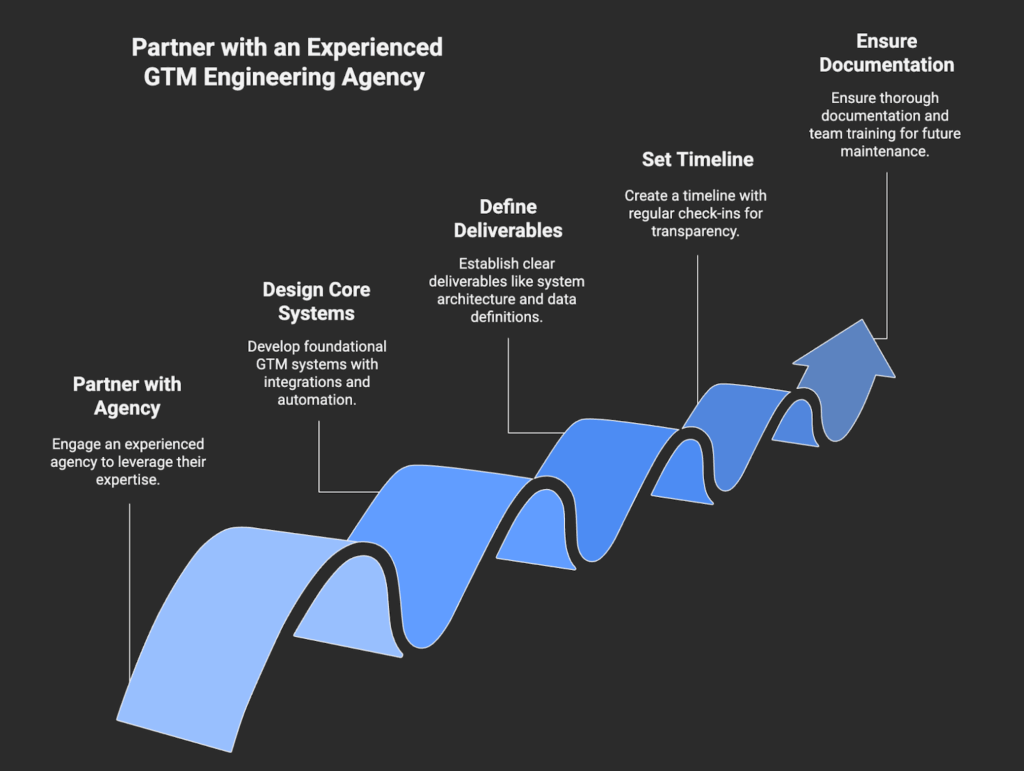
Build a GTM Engine Designed to Scale
GTM engineering gives growing companies the revenue infrastructure needed to scale efficiently. It connects strategy to execution through integrated data pipelines, automated workflows, and shared reporting that provides every team with a clear view of the customer journey. With this foundation in place, teams can work together using the same information and execute more efficiently at every stage of the funnel.
For early-stage startups, go-to-market and outreach efforts are critical for growth, but scaling them can get expensive fast. The costs of tools and the number of seats required can add up quickly. mvpGrow specializes in helping startups meet ambitious growth targets by leveraging a lean tech stack and innovative AI tools to take on the heavy lifting. This approach gives startups the capacity to scale quickly without requiring an excessive budget. You also leverage the benefits of working with a full-service marketing agency and an experienced global team. Book a free consulting call with mvpGrow to scope a custom GTM engineering blueprint aligned to your goals.

The Founder & Chief Getting Sh%T Done Officer of mvpGrow. After about 8 years as a hired hand some of the largest (and smallest) B2B SaaS companies worldwide I decided to hang up my employee slippers and lace up my growth agency cleats. But just because I’m an agency doesn’t mean we can’t chat (no charge). Please email me on any topic and I will gladly reply: eyal@mvpgrow.com
